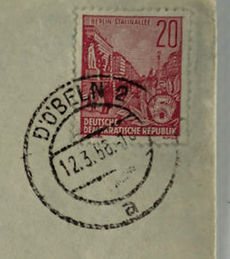

Hoa Mai
Opening Title
The drama of “Hoa Mai” tells the story of a young Vietnamese woman’s life after the Vietnam War and her escape to Germany.
The Opening Title is an animated analogy narrative to the fictional feature film, which presents the credits and sets the atmosphere for the following movie.


My role on this project
From concept to final artwork
Directing
Generating the idea and movie concept, research on 70s and 80s Vietnam and Eastern Germany, research on Opening Titles, conducting a target group survey and benchmarking. Developing the Title concept, story, style, a sound concept and managing the project.
Animating
Animating and post production was done in cooperation with Anna Rimmer, who brought special knowledge of that field to the project.

Target Group Survey
Interest and expectations of a contemporary audience
For the production of the “Hoa Mai” opening title it was important to find out which contents and appearance a contemporary opening title should have. For this purpose, relevance and attention on title sequences were examined in form of a target group survey with 100 participants in order to understand the needs and desires of the current, contemporary audience better.

Animation Concept
Why a 2D animated Opening Title for a live action feature film?

Emotional contrast
Cartoons and animated movies are, because of their playful style, often mistakenly associated with content for children. Thus, choosing a playful way to underline a rather serious drama creates a contrast which emphasizes the sad and serious topic of war. Seen through a child’s eye, it gets both lighter and more tragic.


Visual contrast
Additionally, the difference in style from the movie puts more attention to the Opening Title, which was the intention for Hoa Mai. The Title stands out as an independent artwork on its own.
The symbol
The symbol
Telling the whole story in an encrypted way
I chose a package as a narrative device for the title sequence.
It travels just like Hoa Mai - the protagonist of the drama. In fact, the viewers will see it in the first scene of the movie and again in the last one.
This connection creates not only a smooth transition to the movie, but a metaphor that tells the whole story in an encrypted way.
When watching the title sequence as a “closing title” after the movie, the audience can understand the metaphor, and appreciate the symbolism between Hoa Mai’s story in the movie and the package told in every scene of the title sequence.


The title sequence starts with an empty package.
This stands for Mai's first idea of going abroad to support the family financially living in poverty.
Next it gets filled up with food, clothes, medicine and money.
The parallel to the film is Mai's preparations she has to make like building contacts, signing up for waiting lists, collecting required documents and money.

As Mai continues, she has to find out where exactly her destination is and find more money for the plane ticket.
In the opening title, this is represented by a label with the destination address and the payment of the stamp.

The transport of the package stands for Mai's flight to Germany.
Upon arrival, some obstacles await her. Her passport is taken away and the package also loses its label which gets torn off during unloading.
Without identity and a place to go, Mai struggles during her first time in a foreign culture and is just as lost as the package that falls off the wagon and goes astray.

Some take advantage of Mai's defenselessness, robbing her of her belongings.
Similarly, the package is torn open and all valuables are stolen from it.
The torn package stands for the mental and physical injuries that Mai suffers from this darkest time of her journey.

Unexpectedly, a Vietnamese official listens to her story and saves her from further misfortunes by issuing her a new passport. In this way, Mai regains her identity and a first piece of her self-esteem.
In the opening title, this is represented by a hand that relabels the package and puts it back on track.

In the final scene, the package arrives in a village in Vietnam, dented and with cracks but fulfilling its purpose.
This stands for Mai, who reaches her destination exhausted, but happy and relieved.
Style
Vietnamese posters and stamps
Visual inspiration for the animation style were vietnamese posters and stamps, especially illustrated ones made by linocut and screen printing.
The decision was to use a flat, rough style that has a hand-drawn, printed look.
Contours are made by color contrasts.
Shadows come out less strong due to the flat representation.
Overall, the style is reduced, but with all necessary details.



Another source of inspiration has been the title sequence for “The Good Lord Bird” (2020), which also uses flat and graphic elements and accompanies a rather tragic content with playful images.



Colours
There are three dominant colors
A neutral yellow as a base, accompanied by a dangerous red and completed by the green of hope and protection.
Like the movie, the title sequence is divided into three acts. Each colour being dominant in one of the three acts.
The colours are muted, but at the same time friendly, to fit the style of the narrative.

Neutral yellow
The first act is the start of Hoa Mais journey and is calm.

Dangerous red
The second act is marked by shorter scenes which increase the tension, and culminates in the climax.

Green of hope and protection
After the rescue in the third act and the arrival at the destination, the atmosphere is calm and peaceful again.
Typography
Simple, but with a nostalgic note


A uniform look for all credits – rather then to integrate them directly in the picture – makes the names stand out more. The font is simple, but with a nostalgic note that deepens the reference to the time of the movie.
The style reference were vietnamese parcel stamps of documents from the 1970s and 80s which were provided by witness Ta Mai Dung.





Handwritten calligraphy
The only exception to the font is the Main Title. It is inspired by handwritten Vietnamese calligraphy.
In Vietnam, this calligraphy is used on special occasions and holidays. For Hoa Mai, the style combines two important aspects of the main character: her roots in Vietnamese culture, but also being special among many.
Audio
Titlesong
The chosen Title song “Hạt Gạo Làng Ta” (1975) is a well-known traditional Vietnamese song.
It is atmospheric and has a great connection to the content of the film "Hoa Mai", especially through the young voice of 10-year old singer Mỹ Anh.
The girl sings about simple farm life, helping her mother in plowing with the buffaloes at the river, cooking rice for the people during war and the struggles that come with it.
Sounddesign by Steve Wühr.






